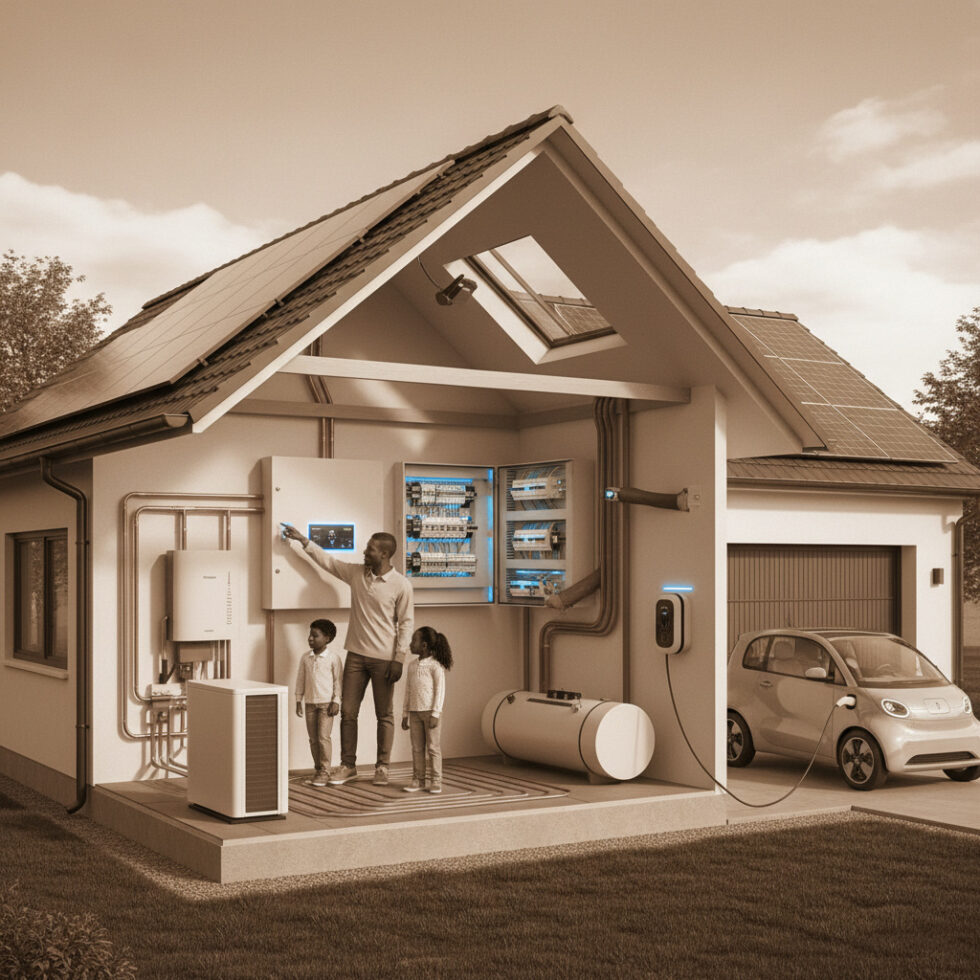
Why Electrify the Home Now
Electrifying your home sounds big, but the basics are straightforward: replace fossil-fuel appliances with efficient electric ones, add smart control to manage loads, and use your car or a battery to ride out outages. You don’t have to do it all at once. Small steps compound. The technology has matured, costs are coming down, and today’s gear is easier to install than many assume.
Electrification is about three things: comfort, cost control, and cleaner air. Modern heat pumps are efficient heaters and air conditioners in one box. Induction cooking is fast and precise. Heat pump water heaters and dryers sip power compared with traditional units. Smart panels help you avoid expensive electrical upgrades. And an EV can act like a giant mobile battery for your home when the grid has trouble.
This guide explains how each piece works, how they fit together, and realistic ways to phase them in—even if you’re renting or living in an older house with a modest electrical panel.
The Core Kit: What Changes, What Stays, and What You Gain
Space Heating and Cooling: Heat Pumps, the Two-in-One Upgrade
A heat pump moves heat instead of making it. That’s why it’s efficient. In cooling mode, it’s an air conditioner. In heating mode, it runs in reverse. Today’s systems can deliver two to four units of heat for every unit of electricity used (a coefficient of performance, or COP, of ~2–4). Cold-climate models keep working at sub-freezing temperatures. For most homes, a right-sized heat pump can replace or back up a furnace.
- Central ducted heat pumps replace a furnace and central AC in one step. Good if you already have ductwork.
- Ductless “mini-splits” use one or more wall- or ceiling-mounted indoor heads. Good for additions, rooms over garages, or homes without ducts.
- Multi-zone systems serve multiple rooms with one outdoor unit. Smart thermostats and room sensors help balance temperatures.
Sizing matters. Oversized units cycle on and off, wasting energy and reducing comfort; undersized units struggle on extreme days. Ask installers to perform a Manual J load calculation (a standardized way to size heating and cooling) rather than guessing from square footage alone.
Look for efficiency labels: SEER2 for cooling, HSPF2 for heating. Cold-climate models often list a rated capacity at 5°F or -5°C—use that number to compare performance in winter.
Hot Water: Heat Pump Water Heaters (HPWHs)
Heat pump water heaters use a small compressor to pull heat from surrounding air. They typically cut hot water energy use by 60% or more compared with electric resistance tanks. Most models include multiple modes: heat-pump-only for maximum efficiency, hybrid for faster recovery, and boost for hosting or holidays. Newer units include 120‑volt “plug-in” models that install without a dedicated 240‑volt circuit, which makes retrofits easier in older homes.
Placement matters. HPWHs prefer rooms with enough air volume. Basements, garages, or utility rooms are common locations. They also dehumidify and cool the surrounding air a bit—handy in warm climates or damp basements.
Cooking: Induction for Speed and Clean Air
Induction cooktops heat pots and pans directly using magnetic fields. Results: fast, precise control, and a cooler kitchen. Many people switch for convenience; some switch for indoor air quality and easier cleanup. If a magnet sticks to your cookware, it likely works on induction. You can try induction with a single portable burner before committing to a full range.
Laundry: Heat Pump Dryers
Heat pump dryers recirculate warm air and remove moisture through a closed loop, which saves energy and reduces heat load in the laundry room. Most models are ventless, which simplifies installation in apartments and tight spaces. Expect longer cycles but lower energy use and gentler drying.
Smart Panels and Load Management: Avoiding Panel Upgrades
Many homes have a 100‑amp or 125‑amp panel. Adding a heat pump, EV charger, and new appliances can look like a panel upgrade is required. In reality, what matters is your peak simultaneous load. Smart panels and load-sharing devices dynamically balance circuits, delaying or throttling loads you don’t need at the same time.
- Smart main panels replace your panel and track power use circuit by circuit. They can shed non-critical loads if you approach your service limit.
- Circuit splitters and load controllers let two devices safely share a circuit (e.g., a dryer and an EV charger) by automatically pausing one when the other runs.
- Integrated demand response allows utilities or aggregators to reduce your use during peak events in exchange for bill credits.
This approach is often cheaper than upgrading service. It can also make your home resilient: when running on a battery or EV, a smart panel can keep essential circuits on and shed others automatically.
EV Charging and “Car as a Battery”
Think of the car as part of the home energy system. Even a modest EV stores far more energy than a typical home battery. New bidirectional charging solutions—often called V2H (vehicle-to-home) or V2G (vehicle-to-grid)—let your EV power essential circuits during an outage or participate in utility programs that pay you for flexibility.
- Level 1 charging (120 V): Adds roughly 3–5 miles of range per hour. Slow but simple for overnight charging.
- Level 2 charging (240 V): Adds 20–40+ miles per hour. Many chargers include Wi‑Fi or LTE and load-sharing.
- Bidirectional chargers: Specialized hardware plus vehicle support. Availability depends on your car and local code.
If your vehicle supports bidirectional power, you can keep key loads running during an outage: fridge, lights, internet, a few outlets, and—if your smart panel is set up to prioritize—your heat pump on low. Not every EV supports this yet, but support is expanding through evolving standards.
Planning Your Upgrade in Phases
Start With a Load Snapshot
Before you buy anything, get a feel for your current energy use and constraints. Gather utility bills for a year to see seasonal patterns. Note your main service rating (100 A? 200 A?), panel space, and existing heavy loads like electric ovens or pool pumps. Simple Bluetooth clamps or utility-provided data can show your actual household peak. The goal: measure before you change.
Pick the First Win
Good first steps reduce cost and friction later. Choose one from this list:
- Induction hotplate to trial faster cooking and better indoor air.
- Load-sharing EV charging so you can add a car without a panel upgrade.
- HPWH to cut water heating bills and dehumidify a damp basement.
- Mini-split for one problem room to boost comfort without redoing the whole HVAC.
Sequence for Minimal Disruption
Here’s a practical order many households use:
- Install a smart panel or targeted load controllers to avoid a panel upgrade later.
- Swap the water heater for a heat pump model.
- Replace space conditioning (furnace + AC) with a ducted heat pump, or add ductless units where needed.
- Go induction for the kitchen—start with a portable unit if unsure.
- Replace the dryer with a heat pump model if your old one fails.
- Add or upgrade EV charging, and consider bidirectional if your car supports it.
You can adjust this sequence to match equipment age. If your AC is fine but the gas furnace is old, a cold-climate heat pump might replace both at once. If your gas line already needs attention, electrification may be the simpler route.
Costs, Savings, and What’s Realistic
Rules of Thumb
Costs vary by region, home layout, and incentives. Here are rough guides to set expectations—always get multiple quotes:
- Ducted heat pump: Often comparable to replacing a furnace plus AC together, especially in new installs. Retrofit costs vary with duct condition.
- Ductless mini-split: Starts lower for one head; scales with zones and complexity.
- Heat pump water heater: Usually higher upfront than a standard tank but often pays back in a few years through lower bills.
- Induction range: Similar to quality electric ranges; portable units are inexpensive.
- Heat pump dryer: Higher upfront, lower operating cost; ventless install can reduce project costs.
- Smart panel or load controllers: Often cheaper than a panel upgrade, with the bonus of circuit-level data and outage modes.
Savings come from three levers: higher efficiency, smarter timing, and reduced maintenance. Heat pumps mean fewer combustion parts to service. Induction keeps kitchens cleaner. Smart panels align heavy loads with off-peak pricing if your utility offers time-based rates. Stack that with demand response credits, and the numbers improve further.
What If My Electricity Is Expensive?
Electricity rates vary. Efficiency changes the math. A heat pump water heater with a COP of ~2.5 uses around 60% less energy than a standard electric tank. A high-performance heat pump can replace fuel in many climates with good comfort and total bill savings, especially if you can pre-heat or pre-cool during cheaper hours. Smart controls are key.
Comfort, Noise, and Everyday Experience
Comfort
Heat pumps deliver steady, even heat. Instead of high blast-and-coast cycles, you get consistent temperatures. Ductless heads can be zoned—warm the living room in the evening, hold the bedroom cooler. In summer, variable-speed compressors keep humidity in check better than many single-stage AC units.
Noise
Modern equipment is quiet. Place outdoor units on vibration pads and away from bedroom windows. Induction cooktops hum softly at high power; most people find them quieter than gas hissing or metal clicking. Heat pump dryers are generally quieter than vented models.
Cooking Feel
Induction brings water to a boil fast and offers precise low simmer control. You’ll use less ventilation, and cleanup is easy because the glass doesn’t get as hot. If you love flame, try a portable induction unit for sauces and searing; many cooks switch full-time after a month.
Resilience: Keeping the Lights On
Essentials-Only Mode
When using a battery or bidirectional EV, you don’t need to power everything. A smart panel can prioritize the essentials—internet, lights, fridge, a few outlets, and efficient heating on low. A well-insulated home with a right-sized heat pump can maintain safe indoor temperatures on minimal power.
EV as Backup
Even a midsize EV can power essentials for days. You’ll need a compatible car, a bidirectional charger, and the right transfer equipment. Many early solutions are turnkey kits. Expect this to get simpler over time as standards mature.
Renters and Older Homes: What Works Without Renovation
- Portable induction cooktops plug into a standard outlet.
- Window heat pumps and compact ductless units can serve rooms without permanent alterations (ask your landlord).
- Heat pump dryers often need only a standard outlet and no vent.
- 120‑volt HPWHs are emerging options for water heating where a 240‑volt line is not available.
- Level 1 EV charging uses a regular outlet if you have assigned parking with power.
If you can’t change the panel, look for devices labeled “plug-in,” “120 V,” “ventless,” or “portable.” Many deliver most of the benefits without permanent changes.
Standards, Safety, and Future-Proofing
Electrical Code and Permits
Licensed electricians understand local code. They’ll ensure correct wire gauges, overcurrent protection, and disconnects. For HVAC, ask about condensate management and refrigerant handling. For water heaters, plan for drainage and condensate lines. Solid permitting protects you and future buyers.
Control and Interoperability
Choose products that support open or documented APIs, or at least offer local control and data export. For demand response, utilities often use OpenADR or built-in programs from your device vendor. Aim for gear that can respond to pricing signals or schedules, even without cloud dependence.
EV Charging Standards
Bidirectional features depend on car and charger support. As standards evolve, more vehicles will enable V2H and V2G. If you’re not ready now, pick an EVSE (charger) that can accept updates, so you don’t need to replace hardware later.
Common Myths, Clarified
- “Heat pumps don’t work in cold climates.” Modern cold-climate systems do. Check their low-temperature capacity ratings.
- “Induction needs special wiring.” Many induction ranges use the same circuit as an electric range; portable units use a standard outlet.
- “HPWHs make rooms too cold.” They cool some air as they run. In most basements and garages, that’s a bonus. In tight spaces, ducting or hybrid modes help.
- “I must upgrade my panel first.” Not always. Smart panels and load controllers can delay or avoid upgrades.
- “Electrification is all-or-nothing.” It’s modular. Replace appliances at end of life and sequence projects to fit budget.
Bill Strategy: Using Time and Data
Time-Based Rates
Many utilities offer time-of-use pricing: cheaper at night and weekends, higher in late afternoon and early evening. Program your heat pump to pre-heat or pre-cool when rates are low. Run the HPWH in efficiency mode off-peak. Charge the EV overnight. A smart panel can automate this across circuits.
Demand Response
Enroll thermostats, water heaters, or EV chargers in utility programs. You agree to slight adjustments during system peaks in exchange for credits. Most events are short and unobtrusive. Even a few events a month can offset device costs over time.
Track and Tune
Circuit-level monitoring shows what’s driving your bill. You can see if a dehumidifier is running constantly, or if an older fridge is a quiet energy hog. Use this data to set priorities and catch problems early.
Putting It All Together: A Sample Roadmap
Scenario A: 100‑Amp Panel, Older Equipment
You live in a 1970s home with a 100‑amp panel. The gas water heater is over 10 years old. AC is aging. You’re considering an EV.
- Install load-sharing EV charging and a smart panel module for the highest draw circuits.
- Replace the water heater with a heat pump water heater. Use hybrid mode during the day, efficiency mode overnight.
- Swap the furnace and AC for a cold-climate heat pump. Keep existing ducts; seal and balance them.
- Add a portable induction burner to test, then upgrade the range later.
- Enroll in time-of-use rates and a demand response program for the heat pump or water heater.
Result: No panel upgrade, lower bills in summer and winter, and improved comfort.
Scenario B: Apartment or Rental
No panel access, no renovations allowed.
- Use a portable induction burner and a countertop convection oven.
- Swap in a ventless heat pump dryer if allowed; otherwise, use a heat pump drying rack concept with a dehumidifier on a timer to speed air drying.
- Add a window or portable heat pump in the main living space.
- If you have an EV, stick to Level 1 charging or nearby public Level 2.
Result: Faster cooking, better air, and lower energy use without permanent changes.
Scenario C: Suburban Home, Considering Backup Power
You want resilience for outages but don’t want a permanent generator.
- Install a smart panel and define an essentials-only circuit group.
- Choose an EV and charger that support bidirectional power when available in your region.
- Optionally add a small stationary battery to bridge short outages and coordinate with the EV when home.
- Use time-of-use programming to shift loads and capture savings.
Result: Quiet backup without fuel storage, plus everyday bill control.
Maintenance and Lifespan
- Heat pumps: Rinse outdoor coils gently, replace filters regularly, keep vegetation clear, and schedule periodic professional checks.
- HPWHs: Clean air filters, ensure condensate drains, and check the anode rod per manufacturer guidance.
- Induction: Wipe the glass surface; avoid dragging cookware to prevent scratches.
- Smart panels and chargers: Keep firmware current; use vendor-recommended surge protection.
With basic care, these systems last as long or longer than the fossil-fuel gear they replace, and they run cleaner.
What’s Next: Tighter Integration, Better Software
Tomorrow’s home energy systems will be more coordinated. Expect heat pumps that tune their output based on electric rates and weather forecasts, HPWHs that function as small thermal batteries, and EVs that plug into home circuits as easily as they plug into public fast chargers. The key trend is orchestration: every device speaks the same language about timing and priority.
For you, that means simpler choices. Pick equipment that can respond to schedules or prices, and you’ll benefit from today’s savings and tomorrow’s features.
Summary:
- Modern heat pumps deliver efficient heating and cooling, even in cold climates, and improve comfort.
- Heat pump water heaters and heat pump dryers cut energy use with simple installations, often without new vents or 240‑V circuits.
- Induction cooking is fast, precise, and helps indoor air quality; try a portable unit before upgrading the range.
- Smart panels and load controllers can avoid expensive panel upgrades by managing peak loads.
- EVs can provide backup power with bidirectional charging and integrate into utility programs for savings.
- Phase upgrades to fit your budget and equipment life; start with the easiest wins.
- Use time-of-use pricing and demand response to shift loads and lower bills.
- Choose gear with open controls and update paths to future-proof your home.





